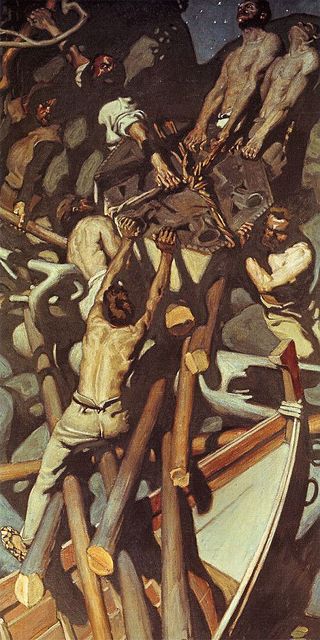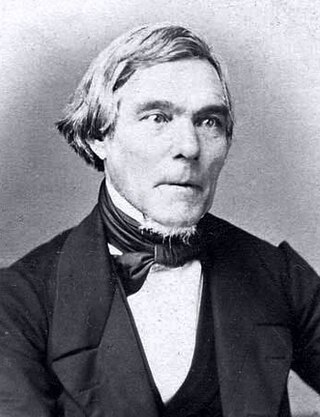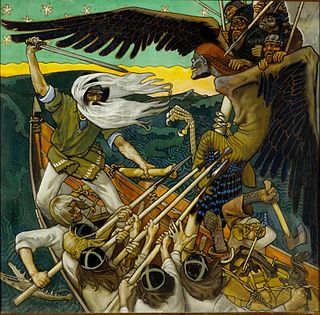
Keno Don Hugo Rosa, known as Don Rosa, is an American comic book writer and illustrator known for his Disney comics stories about Scrooge McDuck, Donald Duck, and other characters which Carl Barks created for Disney-licensed comic books, first published in America by Dell Comics. Many of his stories are built on characters and locations created by Barks; among these was his first Duck story, "The Son of the Sun" (1987), which was nominated for a Harvey Award in the "Best Story of the Year" category.

The Kalevala is a 19th-century compilation of epic poetry, compiled by Elias Lönnrot from Karelian and Finnish oral folklore and mythology, telling an epic story about the Creation of the Earth, describing the controversies and retaliatory voyages between the peoples of the land of Kalevala called Väinölä and the land of Pohjola and their various protagonists and antagonists, as well as the construction and robbery of the epic mythical wealth-making machine Sampo.

In Finnish mythology, the Sampo is a magical device or object described in many different ways that was constructed by the blacksmith Ilmarinen and that brought riches and good fortune to its holder, akin to the horn of plenty (cornucopia) of Greek mythology. When the Sampo was stolen, Ilmarinen's homeland fell upon hard times. He sent an expedition to retrieve it, but in the ensuing battle it was smashed and lost at sea.

Gyro Gearloose is a cartoon character created in 1952 by Carl Barks for Disney comics. An anthropomorphic chicken, he is part of the Donald Duck universe, appearing in comic book stories as a friend of Donald Duck, Scrooge McDuck, and anyone who is associated with them. He was also a heroic creator star of the animated DuckTales. He first appeared in the Carl Barks comic "Gladstone's Terrible Secret", and was the regular lead character in 4-page backup stories in Barks' issues of Uncle Scrooge, starting with issue #13 and continuing through #41.

The Donald Duck universe is a fictional shared universe which is the setting of stories involving Disney cartoon character Donald Duck, as well as Daisy Duck, Huey, Dewey, and Louie, Scrooge McDuck, and many other characters. Life in the Donald Duck universe centers on the city of Duckburg and is a part of the larger Mickey Mouse universe. In addition to the original comic book stories by Carl Barks, the Duckburg cast was featured in Little Golden Books, television series such as DuckTales (1987–1991), Darkwing Duck (1991–1992), and the DuckTales reboot (2017–2021), and video games such as DuckTales (1989), QuackShot (1991), Goin' Quackers (2000), and DuckTales: Remastered (2013).

Elias Lönnrot was a Finnish physician, philologist and collector of traditional Finnish oral poetry. He is best known for creating the Finnish national epic, Kalevala (1835, enlarged 1849), from short ballads and lyric poems gathered from the Finnish oral tradition during several expeditions in Finland, Russian Karelia, the Kola Peninsula and Baltic countries.
Finnish mythology commonly refers of the folklore of Finnish paganism, of which a modern revival is practiced by a small percentage of the Finnish people. It has many shared features with Estonian and other Finnic mythologies, but also with neighbouring Baltic, Slavic and, to a lesser extent, Norse mythologies.

Ilmarinen, a blacksmith and inventor in the Kalevala, is a god and archetypal artificer from Finnish mythology. He is immortal and capable of creating practically anything, but is portrayed as being unlucky in love. He is described as working the known metals of the time, including brass, copper, iron, gold, and silver. The great works of Ilmarinen include the crafting of the dome of the sky and the forging of the Sampo. His usual epithet in the Kalevala is seppä or seppo ("smith"), which is the source of the given name Seppo.

Väinämöinen is a demigod, hero and the central character in Finnish folklore and the main character in the national epic Kalevala by Elias Lönnrot. Väinämöinen was described as an old and wise man, and he possessed a potent, magical singing voice.

Tuonela is the realm of the dead or the Underworld in Finnish mythology. Tuonela, Tuoni, Manala, Vainajala and Mana are used synonymously. Similar realms appear in most Finnic cultural traditions, including among Karelian, Ingrian, and Estonian beliefs. In Estonian mythology, the realm is called Toonela or Manala. Tuonela can also refer to a grave or a graveyard.

Pohjola, sometimes just Pohja, is a location in Finnish mythology. It is one of the two main polarities in the Finnish national epic, the Kalevala, along with Kalevala or Väinölä.

Lemminkäinen or Lemminki is a prominent figure in Finnish mythology. He is one of the heroes of the Kalevala, where his character is a composite of several separate heroes of oral poetry. He is usually depicted as young and good-looking, with wavy red hair.

Sampo is a 1959 Soviet–Finnish fantasy film based loosely on the events depicted in the Finnish national epic Kalevala. In the United States, it was released in an edited version, The Day the Earth Froze, by American International Pictures as a double feature with Conquered City. This version was later featured in a 1993 episode of Mystery Science Theater 3000.
This is a summary of the cantos of the Kalevala.
Iku-Turso is a malevolent sea monster in Finnish mythology, best known for appearing in the Kalevala. Nowadays Meritursas means octopus in Finnish, named after Iku-Turso, but originally tursas is an old name for walrus while the more common term is mursu. However, it is more common to see the word mustekala, the name of its Subclass Coleoidea in Finnish, for the octopus.
In Finnish mythology, the Nine diseases are the sons of Loviatar, the blind daughter of Tuoni. She is impregnated by wind. According to the version told in the Kalevala they are Pistos (consumption), Ähky (colic), Luuvalo (gout), Riisi (rickets), Paise (ulcer), Rupi (scab), Syöjä (cancer), and Rutto (plague). The ninth, a witch and the worst of all, remains unnamed. He, the personification of envy, is banished by his mother to become the scourge of mankind. Other rune versions mention nine diseases by name the witch being the tenth son. Some of them also use more esoteric names such as Nuolennoutaja, Painaja, Kielen kantaja, Ohimoiden ottaja, and Sydämen syöjä, which can as well be interpreted as names of diseases. Louhi, the Mistress of North who acts as a midwife to the sons, sends them to Kaleva where they are defeated by Väinämöinen.

"A Little Something Special" is a 1997 Disney comics story created by Don Rosa to celebrate the 50th anniversary of Scrooge McDuck's first appearance in Carl Barks's "Christmas on Bear Mountain" in 1947.

The Defense of the Sampo is a tempera-on-canvas Romantic national painting created in 1896 by Finnish painter Akseli Gallen-Kallela. The painting illustrates a passage from the Kalevala, the Finnish national epic compiled by Elias Lönnrot in the 19th century.

"Gyro's First Invention" is a Gyro Gearloose story by Don Rosa that also features Donald Duck, Scrooge McDuck, and Huey, Dewey, and Louie. It is a 50th anniversary story for the character of Gyro Gearloose, as well as a sequel to A Christmas for Shacktown by Carl Barks, and tells of the creation of Gyro's Little Helper.















